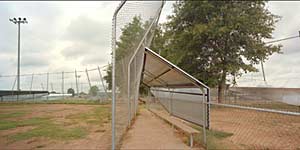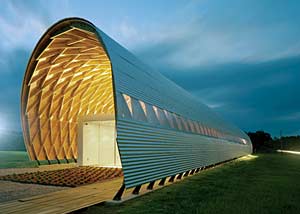Design-build educators talk pedagogy and real politick.
AR: What long-term effects have your design-build programs wrought on their communities? Are community members learning new construction skills, like the Navajos, for example?



Louis: What I’ve found, especially with the Rosie Joe House, is that it afforded her the opportunity to go back to weaving rugs, which now command as much as $10,000. Previously she had to give up the loom to be a receptionist at Motel 6 or waitress somewhere else. Another woman has gone back to teaching at elementary school, whereas she was continually taking care of her parents before.
Badanes: It’s the students who really feel the long-term effects. Our goal is to deflect them from finishing architecture school and taking their portfolio to an office and getting a job. We’re trying to create a different kind of architect. Our most successful people have become nonprofit housing developers, developers of community gardens, and a lot of them have gone into design-build, which from my experience is a bit more satisfying than the office alternative, especially as things become more automated. We teach building and practical things, but the real lessons are perseverance and self-motivation, teamwork, and community service. It’s a big agenda. I think that’s where we can make a real difference.
Dutton: That’s one of the things I’ve learned from Steve Badanes. We’re not just trying to help a community, but we’re trying to deconstruct students’ privilege. We’re trying to get them to be better citizens, better community advocates, and to understand the complexity of urban areas. We’d like to institutionalize ourselves even more into that community—develop job-training programs, get high school industrial-education kids involved with us—so that the Center is not only a site of student and faculty learning but community learning as well.
Freear: The Rural Studio began 16 years in one place and is becoming a neighbor. I’m starting to see the fruits of that, the trust, of being out in the community. The local politicians and community groups are coming to us now, and they’re actually bringing grants and dollars to the table themselves. It’s great to see they have the imagination and also the courage to be involved with us. I think that’s reflected in the scale of recent projects, like a 40-acre public park, an animal shelter, and a hospital, which may serve more people than all the other projects put together.
From the students’ point of view, I hope they leave here feeling empowered. I know when I left school, I had no idea who to ask or what to do in an office. Everything was a complete mystery to me. At least these students know how an engineer and architect engage in a dialogue, and where to look for things and who to talk to. I hope they have the courage to feel good about their decisions and not by frightened in their decisions.
Hopfner: One thing you’ve heard time and again is this notion of bridging architecture and social conscience, and making architects citizens of a larger community. I think that’s present in all of these programs. One other thing that I’m beginning to push is addressing issues of the profession: Architects have really divorced themselves from the building process. In such a litigious society they don’t build, just design. By exposing students to all of the forces that come to bear on the making of a building, whether environmental, technical, or political, they can begin to harness them to become more effective as architects.
It does manifest itself, too. We have students who have begun their own design-build firms. And we’ve begun looking at the notion of prototyping. Working with Common Ground, potentially these designs may be able to morph in some simple ways to deploy to various sites in the real economy.

Post a comment to this article
Report Abusive Comment